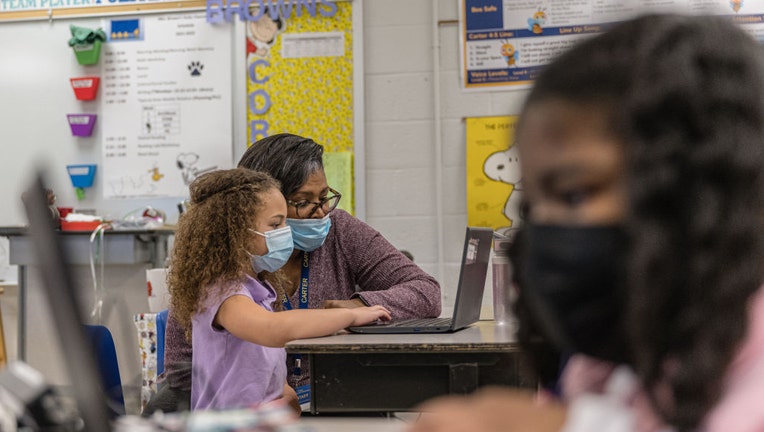Affordable Connectivity Program offers discounts on internet, laptops

Nicole Brown, a second grade teacher, sits at a laptop computer with one of her students during a lesson at Carter Traditional Elementary School in Louisville, Kentucky. (Photo by Jon Cherry/Getty Images)
WASHINGTON - The digital divide is an ongoing issue for some communities nationwide that struggle to access affordable, high-speed internet service and purchase inexpensive computer equipment. But the Biden administration is helping communities in this predicament through a program that has now made internet and the cost of laptops and tablets affordable and available to them through the affordable broadband program.
The White House announced that over 10 million households have enrolled in this program. Here’s what you need to know.
What is the Affordable Connectivity Program?
This is the nation’s largest broadband affordability program and it was created through the Bipartisan Infrastructure Law. Low-income households can apply and receive a partial monthly discount of up to $30 a month for internet service and up to $75 per month for eligible homes on Tribal lands. Households would cover the portion of the monthly service cost that isn’t covered through the discount.
Broadband service providers participating in the Affordable Connectivity Program would receive monthly payments from the households eligible for the program. For more information on service providers in your area, click here.
According to the White House, homes eligible for the program can also get a one-time discount of up to $100 to buy a laptop, desktop computer, or tablet if the household contributes over $10 and less than $50 to the purchase price.
Who is eligible for the Affordable Connectivity Program?
Households that are at or below 200% of the federal poverty guidelines, or if a person in the home meets at least one of the following requirements:
- The individual participates in certain assistance programs, including SNAP, Medicaid, Federal Public Housing Assistance, SSI, WIC, or Lifeline.
- The person participates in Tribal specific programs, including the Bureau of Indian Affairs General Assistance, Tribal TANF, or Food Distribution Program on Indian Reservations.
- An individual is eligible to participate in the National School Lunch Program or the School Breakfast Program, including through the USDA Community Eligibility Provision
- A person in the home receives a Federal Pell Grant during the current award year, or meets the requirement for a participating broadband provider’s existing low-income internet program.
How can you find out if you are eligible for the affordable connectivity program?
To enroll for the Affordable Connectivity Program, households should visit www.ACPbenefit.org, or mail in an application, a household worksheet, and supporting documentation to ACP Support Center, PO Box 7081, London, KY 40742.
If you’re searching for additional information on the affordable connectivity program you can find it by visiting visiting www.fcc.gov/ACP. To find a list of providers in the program, visit www.fcc.gov/affordable-connectivity-program-providers.
How school districts are trying to manage the digital divide for students
The lack of internet access has been problematic for students at schools during the pandemic. A couple of school districts in the U.S. have taken to ensure that students can access the internet.
In Bakersfield, California, the Kern High School District created a new way to provide internet access to students learning from home during the pandemic.
The school district has a fleet of school buses to act as WiFi hotspots on Tuesday, March 31. The buses are scheduled to stop at locations on a route for 30 minutes at a time. Once students are at the stop, directions will be provided on how they can connect to the hotspot.
In Lakeland, Florida, a school district sent out 50 equipped to serve as WiFi hotspots to areas in need of internet service. The buses are available from 7 a.m. to 5 p.m., Monday through Friday at designated sites with more than 80 sites throughout the county.
During those times, students and families in the area can connect to the internet, according to the school district. It's all part of an initiative called Synced for Students.
In Salinas, California, two girls walked to a Taco Bell restaurant and used the WiFi to complete school work on laptops because they didn’t have internet access at home.
Officials with the Salinas City Elementary School District told FOX2 that the state of California has approved 2,500 additional hotspots for students in need, to supplement the 1,500 that have already been distributed. Additionally, the district has handed out more than 8,200 Chromebooks.
In 2020, Representative Jarvis Johnson (D - Houston) and the Texas Legislative Black Caucus asked DARE America to help Houston-area students impacted by the digital divide.
DARE America donated more than 500 computers to Houston area school districts.
That same year, 10 Houston-area churches partnered with the Houston Independent School District (HISD) to make sure students had internet access and other resources by providing a space for them to work when schools held virtual learning classes.
FOX2 San Francisco, FOX6 Milwaukee, FOX13 Tampa, and FOX26 Houston contributed to this story. This story was reported from Washington, D.C.

